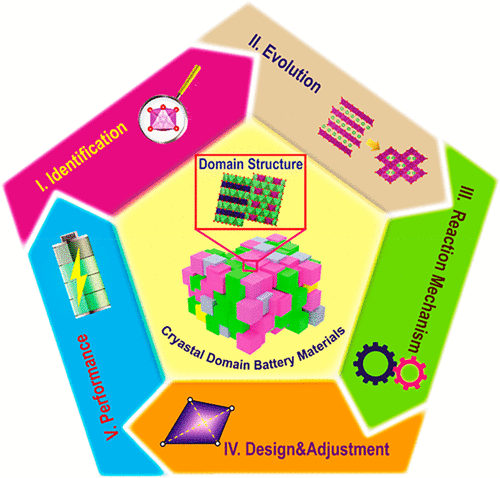当前位置:
X-MOL 学术
›
Acc. Chem. Res.
›
论文详情
Our official English website, www.x-mol.net, welcomes your
feedback! (Note: you will need to create a separate account there.)
Crystalline Domain Battery Materials.
Accounts of Chemical Research ( IF 16.4 ) Pub Date : 2019-11-14 , DOI: 10.1021/acs.accounts.9b00457 Xu Zhang 1 , Haijun Yu 1
Accounts of Chemical Research ( IF 16.4 ) Pub Date : 2019-11-14 , DOI: 10.1021/acs.accounts.9b00457 Xu Zhang 1 , Haijun Yu 1
Affiliation

|
The development of next-generation energy storage materials for secondary batteries relies more and more on the delicate design and tailoring of their local structures and properties. Crystalline domain battery materials (CDBMs) are defined as a family of materials that are hierarchically engineered primarily by bonding selective atoms in certain space groups with short-range order to form nanoscale crystal domains as fundamental constructive and functional units, secondarily by integrating these interactive crystal domains under certain configurations into grains to implement electrochemical synergy, and finally by optimizing grains through nanoengineering toward advanced electrode materials. In CDBMs, adjacent crystal domains can undergo structural co-transformations with noticeable interrelationships, and the overall electrochemical performance is determined not only by the intrinsic structure of each crystal domain (element, bonding, valence, stacking, orientation, etc.) but also by the configuration of crystal domains (size, ratio, interface, distribution, interaction, etc.). Pioneering studies have shown significant enhancement of electrochemical performance by controlling crystal domains, suggesting the prospect of developing novel electrode materials through crystal-domain engineering. However, fundamental understanding and delicate fabrication of this material family, in terms of structural identification, electrochemical structure evolution, reaction mechanism, design and adjustment, and structure-performance relationship, among others, still face great challenges to meet the compelling requirements of high-performance electrode materials for secondary batteries. This Account systematically introduces the structure and electrochemistry of CDBMs. The efficient structural identification of crystal domains, which is still challenging due to their structural complexity, is demonstrated using prototype materials by advanced characterization techniques such as high-energy X-ray diffraction combined with Rietveld refinement and spherical aberration-corrected transmission electron microscopy. Investigations on the structural evolution of CDBMs in electrochemical reactions by ex-situ and in-situ techniques provide insights into reaction scenarios such as how ions migrate in and across crystal domains and how these crystal domains transform synergistically. A crystal-domain reaction mechanism is thus proposed to explain the electrochemistry of these materials. Design principles and adjustment strategies for designated crystal-domain structures including their components, ratios, distributions, and interfaces are deduced from the structural identification, evolution and reaction mechanism. The relationship between crystal-domain structures and electrochemical performance can further be elucidated, inspiring us to explore efficient strategies for optimizing the electrochemical performance, as validated by examples of high-performance batteries using materials with controlled crystal-domain structures. Based on these systematic studies, the trends in the rapid enrichment, deep investigation, and practical application of CDBMs are envisioned to promote continuous studies on this nascent energy storage material family.
中文翻译:

晶域电池材料。
下一代二次电池储能材料的开发越来越依赖于其局部结构和性能的精细设计和定制。晶域电池材料(CDBM)定义为一类材料,这些材料主要是通过以短距离顺序键合某些空间组中的选择性原子以形成纳米级晶域作为基本的结构性和功能性单元,其次是通过整合这些交互作用的晶体而进行分层工程设计在某些构型下将纳米晶域转变成颗粒以实现电化学协同作用,最后通过对先进的电极材料进行纳米工程来优化晶粒。在CDBM中,相邻的晶域可能会发生结构性共转化,并具有明显的相互关系,整体的电化学性能不仅取决于每个晶畴的固有结构(元素,键,价,堆积,取向等),而且还取决于晶畴的构型(尺寸,比率,界面,分布,相互作用,等等。)。开拓性研究显示,通过控制晶畴,电化学性能得到了显着提高,这表明通过晶畴工程开发新型电极材料的前景。但是,从结构鉴定,电化学结构演变,反应机理,设计和调整以及结构与性能的关系等方面,对该材料系列有基本的了解和精巧的制造,为了满足用于二次电池的高性能电极材料的迫切需求,仍然面临着巨大的挑战。该帐户系统地介绍了CDBM的结构和电化学。使用原型材料通过先进的表征技术,例如高能X射线衍射结合Rietveld精细化和球面像差校正的透射电子显微镜,证明了由于晶域结构复杂而仍然具有挑战性的有效结构鉴定。通过异位和原位技术研究CDBMs在电化学反应中的结构演变,可以洞悉反应情况,例如离子如何在晶畴内和晶格间迁移以及这些晶畴如何协同转化。因此提出了晶畴反应机理来解释这些材料的电化学。从结构鉴定,演化和反应机理推导了指定晶域结构的设计原理和调整策略,包括其组成,比例,分布和界面。可以进一步阐明晶畴结构与电化学性能之间的关系,这激发了我们探索优化电化学性能的有效策略,这一点已通过使用具有受控晶畴结构材料的高性能电池示例进行了验证。在这些系统研究的基础上,快速丰富,深入研究,
更新日期:2019-11-14
中文翻译:

晶域电池材料。
下一代二次电池储能材料的开发越来越依赖于其局部结构和性能的精细设计和定制。晶域电池材料(CDBM)定义为一类材料,这些材料主要是通过以短距离顺序键合某些空间组中的选择性原子以形成纳米级晶域作为基本的结构性和功能性单元,其次是通过整合这些交互作用的晶体而进行分层工程设计在某些构型下将纳米晶域转变成颗粒以实现电化学协同作用,最后通过对先进的电极材料进行纳米工程来优化晶粒。在CDBM中,相邻的晶域可能会发生结构性共转化,并具有明显的相互关系,整体的电化学性能不仅取决于每个晶畴的固有结构(元素,键,价,堆积,取向等),而且还取决于晶畴的构型(尺寸,比率,界面,分布,相互作用,等等。)。开拓性研究显示,通过控制晶畴,电化学性能得到了显着提高,这表明通过晶畴工程开发新型电极材料的前景。但是,从结构鉴定,电化学结构演变,反应机理,设计和调整以及结构与性能的关系等方面,对该材料系列有基本的了解和精巧的制造,为了满足用于二次电池的高性能电极材料的迫切需求,仍然面临着巨大的挑战。该帐户系统地介绍了CDBM的结构和电化学。使用原型材料通过先进的表征技术,例如高能X射线衍射结合Rietveld精细化和球面像差校正的透射电子显微镜,证明了由于晶域结构复杂而仍然具有挑战性的有效结构鉴定。通过异位和原位技术研究CDBMs在电化学反应中的结构演变,可以洞悉反应情况,例如离子如何在晶畴内和晶格间迁移以及这些晶畴如何协同转化。因此提出了晶畴反应机理来解释这些材料的电化学。从结构鉴定,演化和反应机理推导了指定晶域结构的设计原理和调整策略,包括其组成,比例,分布和界面。可以进一步阐明晶畴结构与电化学性能之间的关系,这激发了我们探索优化电化学性能的有效策略,这一点已通过使用具有受控晶畴结构材料的高性能电池示例进行了验证。在这些系统研究的基础上,快速丰富,深入研究,










































 京公网安备 11010802027423号
京公网安备 11010802027423号